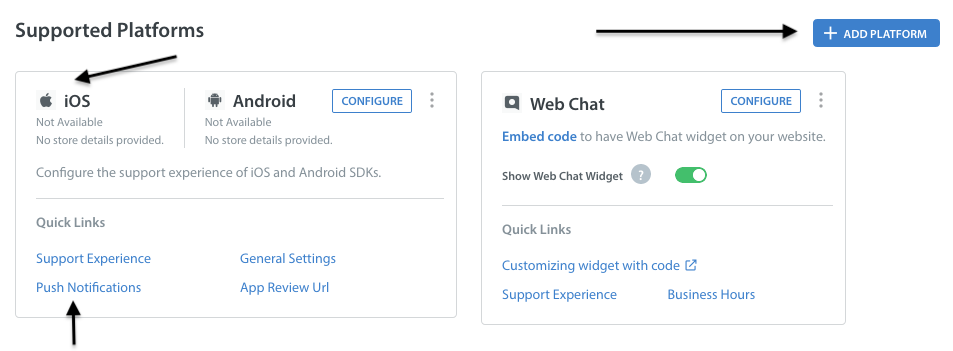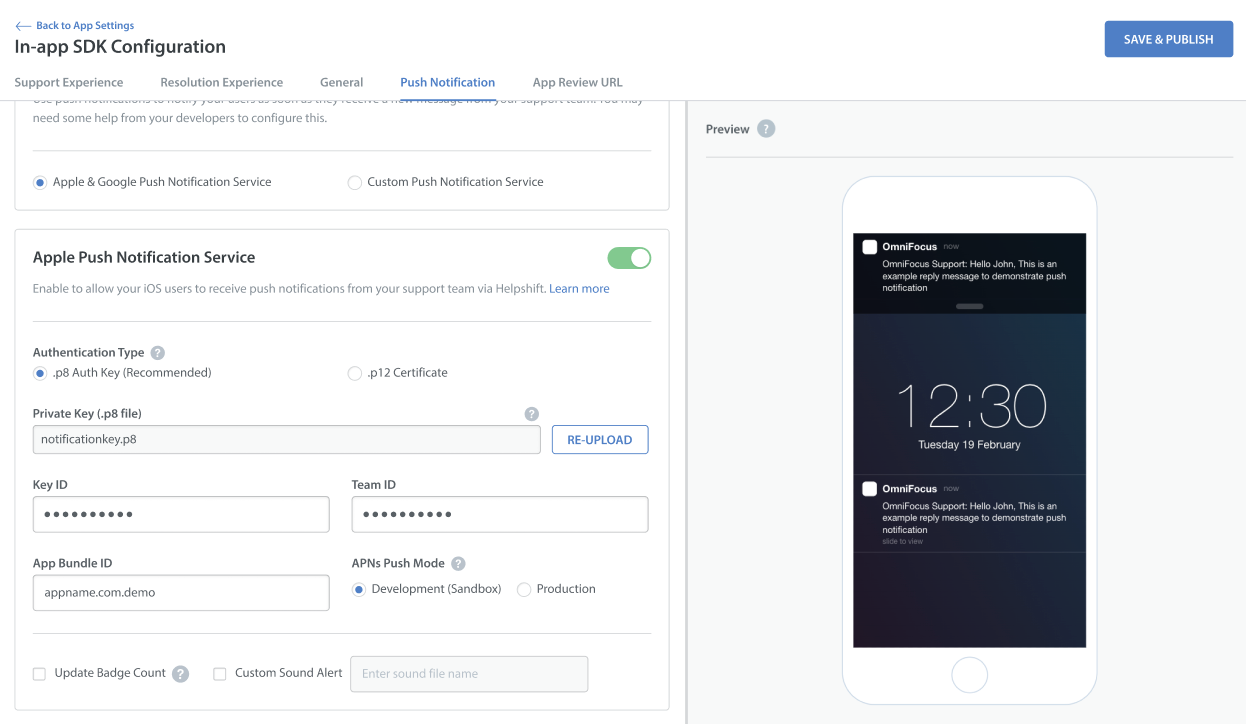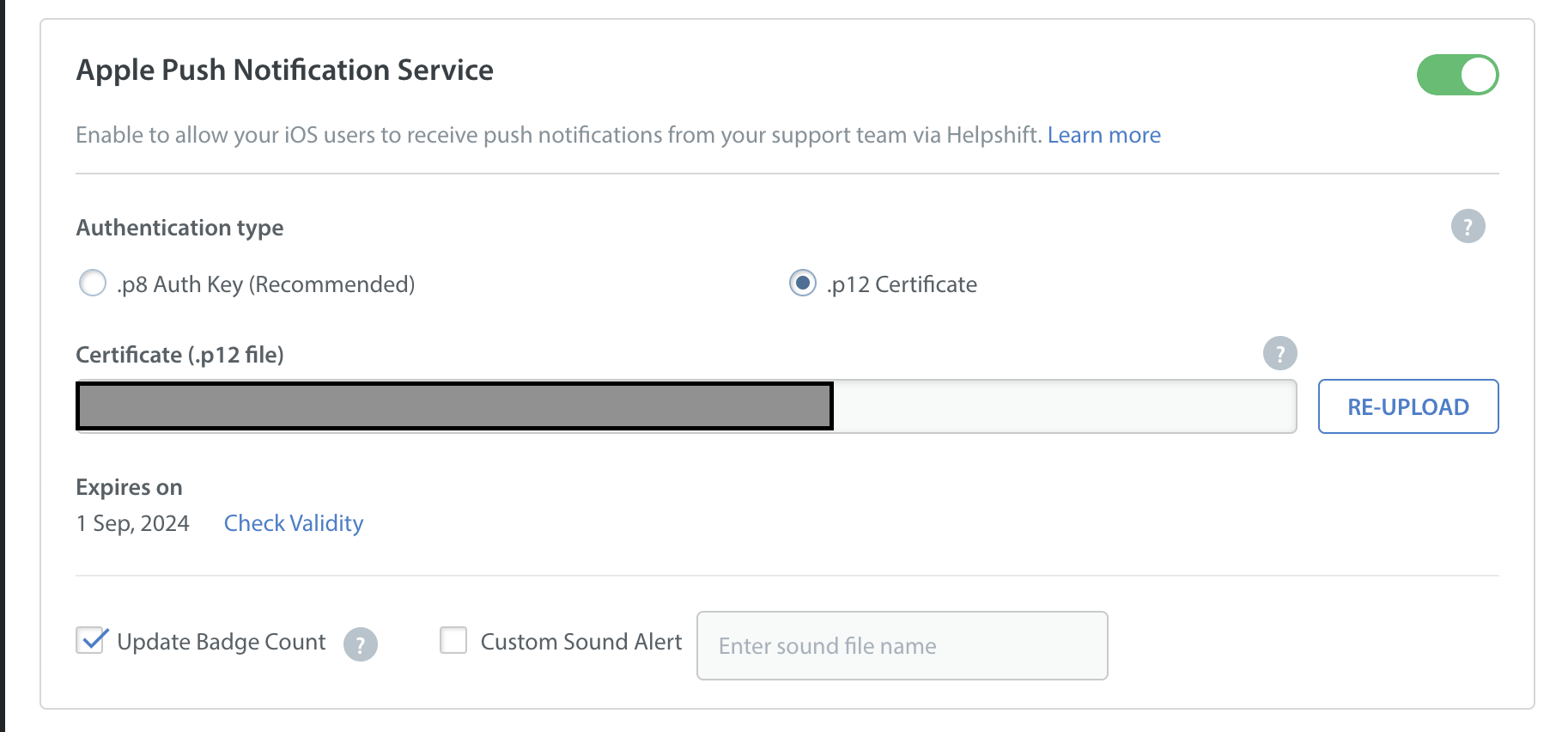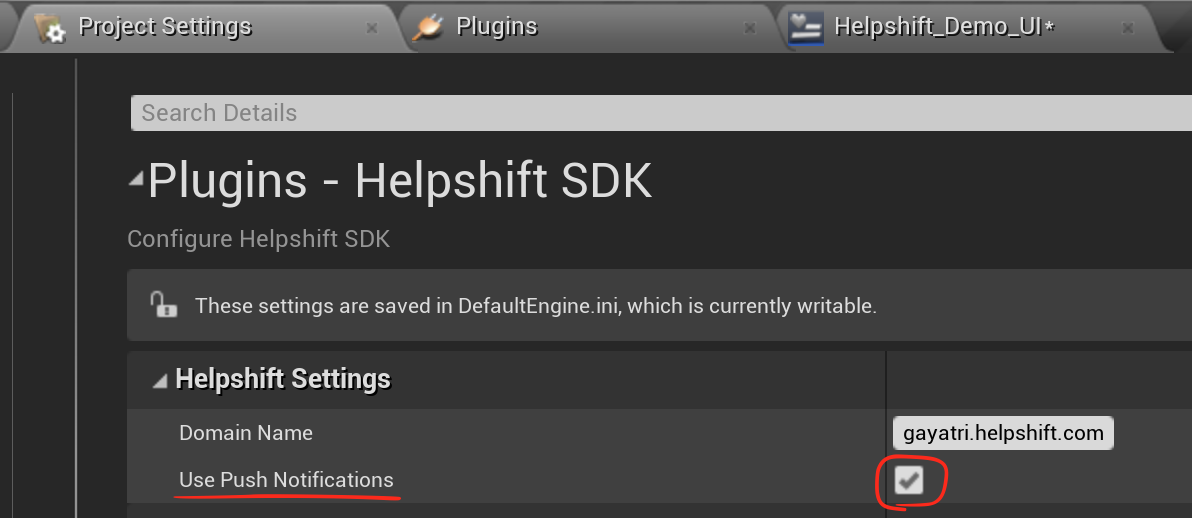Notifications iOS
Configure Push and In-app notifications.
If you want to configure the notifications for Android - please refer here
Configure push notifications via Helpshift
Notifications can be sent to your users when you reply to an issue submitted by them. In addition to the expected Push Notification behavior on iOS, you can customize your notifications to display a numbered badge on your App icon or play a sound alert when a notification is received.
If your app does not already use push, you will need to enable push for your app. To enable push notification in your application you need to add APNS registration code on app launch.
#if PLATFORM_IOS
UNUserNotificationCenter *center = [UNUserNotificationCenter currentNotificationCenter];
center.delegate = self;
[center requestAuthorizationWithOptions:(UNAuthorizationOptionBadge | UNAuthorizationOptionSound | UNAuthorizationOptionAlert)
completionHandler:^(BOOL granted, NSError *_Nullable error) {
...
}];
[UIApplication sharedApplication registerForRemoteNotifications];
...
#endif
Configure Helpshift's push notification service in the Helpshift admin interface
To enable the Helpshift system to send push notifications to your users you will have to add iOS as a platform in your app (if you have not added already). And then click on the push notifications option.

In order to send push notifications to all iOS mobile apps and games, you need to establish an authenticated connection with the Apple Push Notification Servers (APNs). There are two methods you can use to authenticate:
- The newer token-based method (.p8)
- The older certificate-based method (.p12)
Token-based method (.p8)
The token-based method is faster because it offers a stateless way to communicate with APNs. It doesn't require APNs to look up the certificate or any other information related to the provider server.
We now support the newer token-based .p8 key method, which allows you to send notifications to all your iOS apps and games using a single key. You can generate your .p8 key through your Apple developer account, as explained here.

Here are the steps to configure iOS push notifications using .p8 keys:
Go to Settings, then navigate to the APP SETTINGS section to choose the app you want to configure.
On the App settings page, click on the CONFIGURE option next to In-app SDK.
On the In-app SDK Configuration page, navigate to the Push Notification section.
Enable the toggle for Apple Push Notification Service if not enabled. The app selects the p8 key authentication type by default when you enable the toggle for the first time.
Upload the p8 key and fill in all the required details.
Select the APNs push mode (Development/Production).
Click on Save & Publish to save the changes.
Certificate-based method (.p12)
You need to generate certificates for APNS on Apple's portal that you can later provide to Helpshift. This lets Helpshift send push notifications to your users. Apple has moved away from old type of certificates to Apple Push Notification service SSL. There is another option to create Apple Push Notification Authentication Key, but Helpshift does not support this option yet. It's also possible that you still have the old type of certificate that has not yet expired, this is also supported by Helpshift.
Apple provides two variations of Apple Push Notification service SSL
- Apple Push Notification service SSL (Sandbox)
- Apple Push Notification service SSL (Sandbox & Production)
After creating your certificate, download it. Double click on it to import it to the Keychain Access application. In the Keychain Access application, right click on the certificate that was just added, and click export it in .p12 format. Please provide a password while exporting the certificate since we do not accept empty passwords. (Note that if your development private key is not present in Keychain Access, you will not be able to export it in .p12 format.)
After export, login and upload the .p12 file in your app in the Helpshift admin panel. Provide the same password you used while exporting to .p12 format.
Please note that you need to use the same bundle identifier in the app as the one you used to create the APNS certificate.

You can configure whether to send a badge or not, and sound alerts if you provided custom sounds bundled with your app to handle notifications. Save it and you're all set.
Development (Sandbox) mode vs. Production mode
When you build and run your app from Xcode, it is in development (Sandbox) mode. To test push notifications from Helpshift in this mode make sure you choose 'Development Mode' while uploading either of the above two certificate types.
When you publish your app and download from App Store, your app is in Production mode. To test push notifications from Helpshift in production mode make sure you choose 'Production Mode' while uploading a certificate of 'Apple Push Notification service SSL (Sandbox & Production)' type. Sandbox mode certificate will not work on a production environment.
We do not support using the same certificate for both sandbox and production apps. In these cases we recommend you create two separate apps on our dashboard, one in 'Production mode' and the other in 'Development mode'. While testing please use the credentials of the developement mode app. When you are ready to publish, please replace the credentials with those of the production level app.
Your Push Certificate has an expiry date, as indicated in the below screenshot. Helpshift will not send you a reminder when your Push Certificate expires, so please make sure that your developer keeps a tab on the expiry date to reupload the Push Certificate.

Configure the Helpshift Unreal SDK to handle notifications
After you have configured the push notifications in the Helpshift console, you will need to add additional setup in the project, too. First of all, you should enable the Use Push Notifications toggle in the Project Settings:

When push is not configured, Helpshift SDK shows out-of-the-box "in-app notifications" for every message sent by Agents/Bots.
You should call registerDeviceToken API only after you have configured the Helpshift dashboard for push notifications. Calling the registerDeviceToken API without configuring the Helpshift dashboard will stop showing out-of-the-box "in-app notifications" for the end users.
For Helpshift SDK to work with the Helpshift push notification service
you will need to invoke the registerDeviceToken: api call inside the application delegate method
application:didRegisterForRemoteNotificationsWithDeviceToken:
#if PLATFORM_IOS
#import <HelpshiftX_Static/HelpshiftX.h>
- (void) application:(UIApplication *)application didRegisterForRemoteNotificationsWithDeviceToken:(NSData *)deviceToken {
[Helpshift registerDeviceToken:deviceToken];
}
#endif
Handling Push Notification
Add the below notification listeners on app launch. Preferably after Helpshift Init
#include "HelpshiftSDK.h"
#if PLATFORM_IOS
#import <HelpshiftX_Static/HelpshiftX.h>
#include "IOS/IOSAppDelegate.h"
#include "Misc/CoreDelegates.h"
#endif
#if PLATFORM_IOS
NSDictionary* ConvertFStringToNSDictionary(const FString& Json)
{
// Convert FString to NSString
NSString* JsonString = [NSString stringWithUTF8String:TCHAR_TO_UTF8(*Json)];
// Convert NSString to NSData
NSData* jsonData = [JsonString dataUsingEncoding:NSUTF8StringEncoding];
// Deserialize NSData to NSDictionary
return [NSJSONSerialization JSONObjectWithData:jsonData options:0 error:nil];
}
void HandleNotification(NSDictionary *payload,bool isAppLaunch) {
// Check if the "origin" key exists in the dictionary
if ([payload objectForKey:@"origin"] != nil) {
NSString *originValue = [payload objectForKey:@"origin"];
// Now you can use the originValue as needed
if ([originValue isEqualToString:@"helpshift"]) {
// Handle the case when origin is "helpshift"
[Helpshift handleNotificationWithUserInfoDictionary:payload isAppLaunch:isAppLaunch];
} else {
// Handle other cases
}
} else {
// app notifications
}
}
UHelpshiftSettings* Settings = FHelpshiftSDKModule::Get().GetSettings();
if (!Settings->UsePushNotifications) {
UE_LOG(LogTemp, Error, TEXT("Use Push Notifications is not enabled in the Project Settings. Will not register the token."));
return;
}
// Handle notification for foreground & background state
FCoreDelegates::ApplicationReceivedRemoteNotificationDelegate.AddStatic([](FString Json, int State) {
NSDictionary* JsonDict = ConvertFStringToNSDictionary(Json);
bool IsAppLaunch = (State == 3) ? false : true;
if (JsonDict) {
HandleNotification(JsonDict,IsAppLaunch);
}
});
// Handle notification for killed state
NSDictionary *LocalLaunchOptions = [IOSAppDelegate GetDelegate].launchOptions;
if (LocalLaunchOptions) {
NSDictionary *Payload = LocalLaunchOptions[@"UIApplicationLaunchOptionsRemoteNotificationKey"];
HandleNotification(Payload,true);
}
#endif
In-app notifications
In-app notifications, unlike push notifications, appear within your app when it is in use by the user.
These notifications are sent when an agent replies to a customer's issue. Your customers can click on these banners to go straight into the conversation screen.

Configuring In-app notifications
The Helpshift Init call supports flags for configuring SDK behaviour.
Currently we support one flag i.e HelpshiftConfigEnableInAppNotificationsKey.
Enabling/Disabling In-app notifications
| Flag | HelpshiftConfigEnableInAppNotificationsKey |
| Values | true / false |
| Default | true |
If you do not want the in-app notifications support provided by the
Helpshift SDK, please set this flag to false. The default value of this
flag is true i.e in-app notifications will be enabled.
Pausing In-app notifications
If you have enabled in-app notifications, use the API PauseDisplayOfInAppNotification() to pause/resume the notifications. When true is passed to this method, display of in-app notifications is paused even if they arrive. When you pass false, the in-app notifications start displaying.

Showing notification count when replies are sent to the user
To fetch unread messages count from the server you can call RequestUnreadMessageCount(bool FetchFromServer); API. This API will return unread messages count via delegate. Based on the value of FetchFromServer, the locally stored count will be returned if FetchFromServer is false else from the server by fetching remotely when FetchFromServer is true. An example use of this count is to update the badge count to indicate unread messsages. Please note that before calling this method, you need to set the listener for Helpshift events by calling the BindEventDelegate(const FHelpshiftEventDelegate& Callback) API.

When you call this API, you receive the unread count in your event delegate HelpshiftEventReceivedUnreadMessageCount()
Keys in event data: HelpshiftEventDataMessageCount (int), HelpshiftEventDataMessageCountFromCache (int)
- The notification count is fetched via this API from the SDK cache and Helpshift's servers (indicated by the value of
HelpshiftEventDataMessageCountFromCache (int)in the example above). However, the count from Helpshift’s servers is rate limited and it returns the value only if a subsequent call is made to the API, after the reset timeout or when the user just closes the chat screen (whichever is earlier). For an active issue, the reset timeout is 1 minute and 5 minutes for inactive issues.